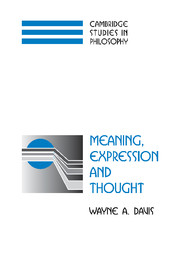Book contents
- Frontmatter
- Contents
- Preface
- 1 Introduction
- Part One Semantic Acts and Intentions
- Part Two Languages and Semantic Acts
- Part Three Thoughts and Ideas
- 12 Thought
- 13 Sentences, Propositions, and Thoughts
- 14 The Constituency Thesis
- 15 Ideas or Concepts
- 16 The Possession of Concepts
- 17 The Acquisition of Concepts
- 18 The Association of Ideas
- 19 Objects, Images, and Conceptions
- 20 The Language of Thought Hypothesis
- Part Four Ideational Theories of Meaning
- References
- Index
13 - Sentences, Propositions, and Thoughts
Published online by Cambridge University Press: 20 July 2009
- Frontmatter
- Contents
- Preface
- 1 Introduction
- Part One Semantic Acts and Intentions
- Part Two Languages and Semantic Acts
- Part Three Thoughts and Ideas
- 12 Thought
- 13 Sentences, Propositions, and Thoughts
- 14 The Constituency Thesis
- 15 Ideas or Concepts
- 16 The Possession of Concepts
- 17 The Acquisition of Concepts
- 18 The Association of Ideas
- 19 Objects, Images, and Conceptions
- 20 The Language of Thought Hypothesis
- Part Four Ideational Theories of Meaning
- References
- Index
Summary
Chapter 12 emphasized the differences between thought and belief, observing that a person can believe something without currently thinking it, and think it without currently believing it. In doing so, however, we presupposed a major point of similarity, namely, that belief and thought can have the same relational objects. Thinking the thought that it will rain and believing that it will rain are different mental states with the same relational object. It is conventional in English and philosophy to refer to the objects of belief as propositions (or statements). To believe that it will rain is to believe the proposition that it will rain. Not all thoughts are propositions, however. We can think “Will it rain?” but this thought cannot be an object of belief or disbelief, and cannot have a truth value. We will define propositions as “declarative” thoughts, and will briefly examine the contrasting category of nonpropositional thoughts. After setting out our standard method of referring to propositions, we will defend the corollary synonymy criterion of propositional identity against the Mates objection and others.
Thoughts, propositions, and beliefs are all closely related to sentences. The fact that thoughts are expressed by sentences, and that speakers use sentences to express thoughts, played a major role in the theory of meaning presented in Parts I and II. We exploit secondary conventions of ideo-reflexive reference (§7.6) in order to use sentences to refer to the thoughts they express.
- Type
- Chapter
- Information
- Meaning, Expression and Thought , pp. 331 - 367Publisher: Cambridge University PressPrint publication year: 2002



